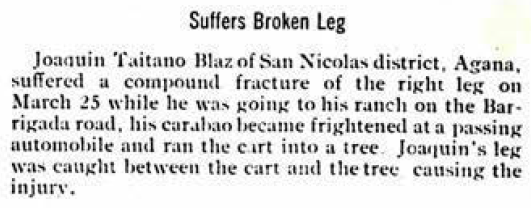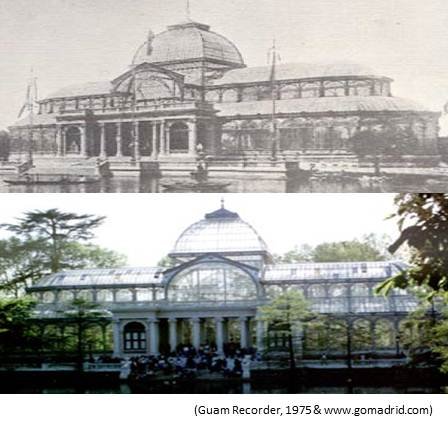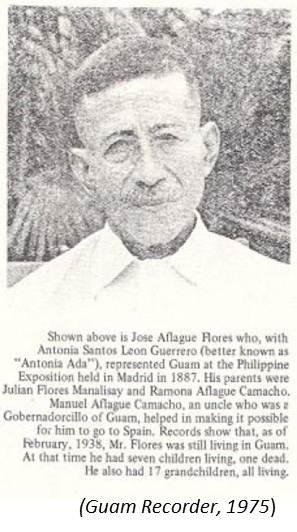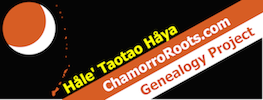Home
Save the Date: April 26, 2014
- Details
Pacific Islander Arts & Crafts Showcase @ Chamaole Pino Restaurant, 607 SE Everett Mall, Everett, WA 98208

Joaquin Taitano Blaz in 1924
- Details
Even a 90 year old short article published in a historical publication such as the Guam Recorder April 1924 edition, can be a meaningful piece of history in one’s family. How many people can recall or have documented a Carabao Bull Cart accident in their family?

[I must admit at the time of this writing I was under the gun and placed more effort toward getting my 1930 Census Book out of editing and proof-reading so that it could be published, printed and out in the market. However, I am committed to blogging at least one article a week, no matter how long or short so here's one. This may continue to be the case until I am able to also complete the 1940 Census transcription project. There are over 1,000 Census sheets to transcribe, so the transcription challenge keeps getter larger.]
Unfortunate Events in 1888
- Details

The following are some 1888 excerpts from the 1971 Guam Recorder article:
At approximately 10:00pm on January 24, 1888, Santiago Garcia, a Pampango "presidario" who had served his term, killed his wife Maria Leon Guerrero. It was believed that the cause for the murder was attributed to jealousy.
On February 27, 1888, Lazaro Pangelinan, a 42 year old bachelor died after falling from a tree while hunting bats in Yona. Previously, he was injured badly by a pig.
On the 18th [month was not disclosed], 1888, Captain Williams, arrived with his new schooner the Esmerelda. The Esmerelda had twice the capacity of his Beatriz schooner [received and delivered mail throughout the Mariana Islands, Micronesia, Philippines, Japan and China among other places.]
On October 4, 1888, Romualdo Gutierrez, a resident of Aniguag and the son of Germenegildo [Hermangildo married to Dolores Nauta] Gutierrez, a Tagalog, fell from a coconut tree and died.
On October 23, 1888, the schooner Esmerelda arrived and was believed to have brought in the measles either from Manila or Yap. One of the passengers was Henry Milimchamp [Millinchamp; husband of Maria de Castro Anderson] was one of the passengers who broke out in a bad rash. A few days later, several of Millinchamp's neighbors had the measles. During this measles epidemic Agana was described as a large hospital. Mostly all of the pregnant women miscarried and many children continue to die through the first days of the 1889 new year.
On November 12, 1888, the drowned body of Luis Baza, a ten year old child, was recovered. Luis was the son of Pedro Baza and Maria Ungagha [Ungacta?].
Source:
----.1971. Relation of Events in the Years 1849-1894, Volume 1, Number 1, pp 53-57. Guam Recorder. Micronesia Area Research Center. University of Guam: Mangilao, Guam.
The 1887 Philippine Exposition in Madrid, Spain
- Details
In 1887, there was a Philippine Exposition held at the Crystal Palace in the Retiro of Madrid, Spain. Victor Balaguer, Spain’s Colonial Minister, was the brain child of the 1887 Exposition. During this particular time period Spain’s empire was fragile and was eroding. Within the Pacific region, its empire included the Philippines, Mariana Islands and many other Micronesian Islands. Part of the reason for having this exposition was because there was an imminent and growing threat by the Germans who encroached the Western Caroline Islands. Furthermore, some scholars contend that it was also during the 1880’s where Dr. Jose Rizal raised Filipino national consciousness. In addition, the Philippine Exposition was also held with the intent of increasing commercial and economic relation between the archipelago (Philippines, Marianas, Carolinas and Belau Islands) and Spain and would further undermine the trade monopoly of the foreign merchants embedded in the Philippines.

Four people from the Micronesian colonies were sent to the Exposition. Two were from the Caroline Islands. Unfortunately, both had met their fate during the Exposition: Dolores Neisern, 22, and Luis Pe-aripis, age 32, described as married and had a son, and was friendly and of humble disposition despite the contrast of his facial features.
The other two were Chamorros: Antonia Leon Guerrero Santos, also known as Antonian Ada, and Jose Aflague Flores, also known as Chubito. Antonia was described an attractive girl, age 22, simple and kind hearted. She compassionately took care of Dolores Neisern before her passing. Jose was described as an accomplished musician, and was modest and unassuming. The participants of the Exposition were impressed with Jose’s intelligence and wit.

Several artifacts and handcrafted islands from the Mariana Islands were used and sent to the Philippines Exposition. Such items included slingstones, adzes, two bone spearheads, and skeletons found from the Calabera cave, in Sa’ipan. Some photos below were extracted from some of the sources of this article.
Although only two Chamorros were sent, the following people of the Mariana Islands sent various items to Madrid for display during the Exhibition:
|
Name |
From |
|
Aflague, Manuel |
Agana, Guam |
|
Castro, Andres |
Agana, Guam |
|
Castro, Ezequiel |
Agana, Guam |
|
Castro, Juan |
Agana, Guam |
|
Cobo, Francisco |
Agana, Guam |
|
Cruz, Dolores |
Agana, Guam |
|
Cruz, Felipe |
Agana, Guam |
|
Diaz, Joaquin |
Agana, Guam |
|
Dungca, Justo |
Agana, Guam |
|
Fausto, Mariano |
Rota/Sa'ipan/Guam |
|
Flores, Manuel |
Agana, Guam |
|
Guerrero, Vicente L. |
Agana, Guam |
|
Herrero, Ana |
Agana, Guam |
|
Herrero, Vicente |
Agana, Guam |
|
Leon Guerrero, Agapito |
Agana, Guam |
|
Leon Guerrero, Joaquin |
Agana, Guam |
|
Leon Guerrero, Lorenzo |
Agana, Guam |
|
Leon, Joaquin |
Agana, Guam |
|
Martinez, Antonio |
Agana, Guam |
|
Martinez, Juan Crisostomo |
Agana, Guam |
|
Millchamp, Enrique |
Agana, Guam |
|
Munoz, Jose |
Agana, Guam |
|
Pangelinan, Manuel |
Agana, Guam |
|
Perez, Jose |
Agana, Guam |
|
Portusach, Jose |
Agana, Guam |
|
Rodes, Antonio |
Agana, Guam |
|
Sablan, Mariano |
Rota/Sa'ipan |
|
Torres, Felix |
Agana, Guam |
|
Torres, Juan |
Agana, Guam |
|
Tudela, Jose |
Agana, Guam |
|
Salas, Jose |
Agana, Guam |
Sources:
Dale S. Miyagi. 1975. Spanish Micronesia and the Philippine Exposition of 1887, 5 no 1, pp. 31-43. Guam Recorder. Micronesian Area Research Center: Mangilao, Guam.
Luis Angel Sanchez Gomez. 2002. Indigenous Art at the Philippine Exposition of 1887, 14 no. 2, pp 283-294. Journal of the History of Collections. Oxford University Press.
Francisco Garcia Olive. 1887. The Mariana Islands 1884-1887, Random Notes (translated by Marjorie Driver). Micronesian Area Research Center: Mangilao, Guam.
Database Update 29 March 2014
- Details
The database has been updated and has grown from 311,410 to 311,833 names.
Page 55 of 84

